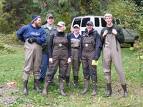
Field trips are one of many teaching methods that can address multiple learning styles. Almost any field trip will have visual, verbal, and kinesthetic (active) elements. People tend to learn more when more of their senses are in use. Field trips will frequently involve hearing, seeing, smelling, touch, and occasionally even taste. If retention is higher (90% in 72 hours) when learners say and do what was taught, field trips can be great for learning retention. (See Learning Styles in Adult Sunday School for more information.)
In a previous blog entry entitled Revolutionary Sunday School Leaders Should Take a Field Trip to Starbucks, I mentioned that Sunday School leaders could learn much from taking a field trip. In today’s entry, I want to suggest that some lessons can benefit from employing the teaching method of the field trip. Now, teaching methods should be used intentionally, purposefully. My definition of the best teaching method is the one that best communicates the truth of God’s Word to that group of people at that particular moment in time. So the first question to ask is whether a field trip is the best method.
For some great information about using this great teaching method, check out Kenneth Gangel’s article Field Trips in Church Education. Gangel offers values of and problems in using field trips an an educational method. He closes the article by offering suggestions for effective use of field trips. His four suggestions are in all capitals followed by my commentary:
-
INVOLVE STUDENTS IN PLANNING FROM THE START.Lead students to do research in advance of the trip. Ask them to study aspects of a passage of scripture. Make assignments in commentaries, Bible dictionaries, atlases, encyclopedia, etc. Tell then what to expect. Make sure the whole group understand when and where it will occur. Give them questions or suggestions of what to look for during the trip.
-
KEEP THE GROUP SMALL. Large groups are harder to ensure quality experiences. With small groups, it is easier to answer questions and easier to listen to what is said. Gangel’s suggestion for a large group is “to divide them into subgroups and have several trips or different sections or platoons, each with its own leader who can guide the learning activities on location.”
-
SELECT WISE TRIP TIMES. Select a time when the majority of the class can participate (and are willing to do so). Select a time when the class can have the best experience. For instance, avoid choosing a time when the site will be too crowded or conditions too poor (like after dark at an outdoor site).
-
PLAN EVALUATION SESSIONS AFTER THE TRIP. Don’t wait to schedule these until after the trip. Schedule them in advance. That helps the class to understand that they are a part of the learning experience. This could be immediately at the end of the site visit. Or it could be when you are back in class. Take time to debrief what was experienced, to reinforce what was learned.
So look over the passages that are coming up in the next month. Which one could best be communicated by using a field trip as the teaching method? How have you used field trips? Press the comments button and share your experiences. Pray. Study God’s Word. Consider the best method for communicating God’s truth. Plan effective field trips. Be revolutionary!
Leave a Reply